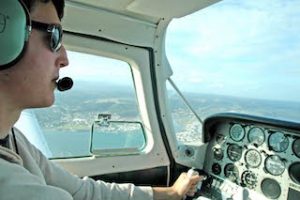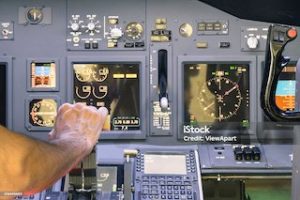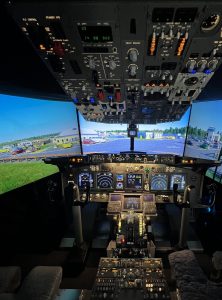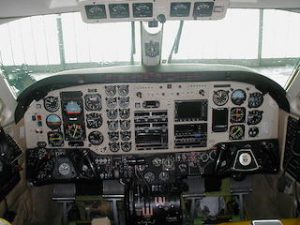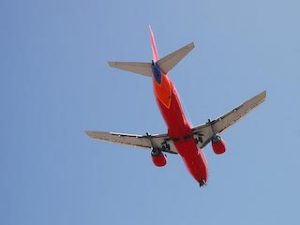Mastering Emergency Procedures in Airline Pilot Standards (APS) Courses
 In the field of aviation, the ability to respond effectively to emergencies is paramount. The Airline Pilot Standards (APS) course provides comprehensive training on emergency procedures, equipping pilots with the knowledge and skills necessary to handle a wide range of critical situations. This article delves into the various emergency procedures covered in APS courses, highlighting their importance and how they contribute to ensuring safety in the skies.
In the field of aviation, the ability to respond effectively to emergencies is paramount. The Airline Pilot Standards (APS) course provides comprehensive training on emergency procedures, equipping pilots with the knowledge and skills necessary to handle a wide range of critical situations. This article delves into the various emergency procedures covered in APS courses, highlighting their importance and how they contribute to ensuring safety in the skies.
The importance of emergency procedures in aviation
Aviation is a complex and dynamic field, with numerous factors that can lead to emergency situations. These can range from mechanical failures and adverse weather conditions to medical emergencies and security threats. The ability to manage these emergencies effectively is crucial for ensuring the safety of passengers, crew, and aircraft.
Emergency procedures are designed to provide pilots with a structured approach to handling unexpected situations. By following these procedures, pilots can make informed decisions, execute necessary actions, and mitigate risks. The APS course places a strong emphasis on emergency procedures, ensuring that pilots are well-prepared to respond to any emergency that may arise during flight.
Key components of emergency procedures training in APS Courses
Emergency procedures training in APS courses is comprehensive, covering a wide range of scenarios that pilots may encounter. The training is designed to develop a deep understanding of emergency protocols and enhance pilots’ ability to respond effectively under pressure.
1) Aircraft system failures
Aircraft system failures are among the most critical emergencies pilots may face. APS courses provide detailed training on handling various types of system failures, including:
-
- Engine failures: Pilots learn to manage engine failures during different phases of flight, including takeoff, climb, cruise, descent, and landing. The training covers procedures for single-engine operation in multi-engine aircraft, engine shutdown, and restart protocols.
- Electrical failures: Handling electrical system failures is crucial for maintaining aircraft functionality. APS courses teach pilots how to manage partial and complete electrical failures, including the use of backup systems and manual controls.
- Hydraulic failures: Hydraulic systems are essential for operating flight controls, landing gear, and brakes. Pilots learn procedures for managing hydraulic failures, including the use of alternate systems and manual reversion techniques.
- Flight control malfunctions: APS courses cover procedures for dealing with flight control malfunctions, such as jammed or unresponsive controls. Pilots learn techniques for troubleshooting and maintaining control of the aircraft.
2) Environmental and weather-related emergencies
Environmental and weather-related emergencies can pose significant risks to flight safety. APS courses provide extensive training on managing these situations, including:
-
- Turbulence: Pilots learn to recognise and respond to different types of turbulence, including clear air turbulence, mechanical turbulence, and wake turbulence. The training covers techniques for minimising the impact of turbulence on the aircraft and passengers.
- Thunderstorms: Flying through thunderstorms can be extremely hazardous. APS courses teach pilots to avoid thunderstorms through weather radar interpretation, route planning, and in-flight decision-making. Pilots also learn procedures for managing inadvertent encounters with thunderstorms.
- Icing conditions: Icing can severely affect aircraft performance and control. APS courses cover procedures for recognising and managing icing conditions, including the use of de-icing and anti-icing systems, and strategies for avoiding areas of known icing.
- Wind shear and microbursts: Wind shear and microbursts can cause sudden and severe changes in aircraft altitude and speed. Pilots learn to detect and respond to these phenomena, including techniques for recovery and escape manoeuvres.
3) Medical emergencies
Medical emergencies can occur at any time during a flight, requiring prompt and effective action. APS courses provide training on managing a range of medical emergencies, including:
-
- Passenger illness or injury: Pilots learn procedures for responding to passenger medical issues, including the use of onboard medical kits, communication with medical professionals, and decision-making regarding diversion to alternate airports.
- Crew incapacitation: APS courses cover procedures for managing situations where a crew member becomes incapacitated. Pilots learn to reassign duties, communicate with ATC, and, if necessary, operate the aircraft with a reduced crew.
4) Security threats
Security threats are a serious concern in aviation, requiring pilots to be prepared for a range of scenarios. APS courses provide training on handling security-related emergencies, including:
-
- Hijacking: Pilots learn procedures for responding to hijacking attempts, including communication protocols, coordination with cabin crew, and strategies for maintaining control of the aircraft.
- Bomb threats: APS courses cover procedures for managing bomb threats, including communication with authorities, passenger evacuation, and aircraft inspection.
- Unruly passengers: Managing unruly passengers is essential for maintaining safety and order on board. Pilots learn techniques for de-escalating conflicts, coordinating with cabin crew, and, if necessary, diverting the aircraft.
Simulation-based training
One of the key components of emergency procedures training in APS courses is the use of flight simulators. Simulation-based training provides pilots with realistic scenarios, allowing them to practice and refine their skills in a controlled environment.
1) Realistic scenarios
Flight simulators used in APS courses are designed to replicate the exact conditions and systems of the aircraft pilots will be flying. This realism helps pilots develop muscle memory and familiarity with the aircraft’s controls and systems. Simulators can recreate a wide range of emergency scenarios, from engine failures and system malfunctions to severe weather conditions and security threats.
2) Hands-on practice
Simulation-based training allows pilots to practice emergency procedures hands-on, enhancing their ability to respond effectively under pressure. Pilots can practice multiple scenarios repeatedly, refining their skills and building confidence. This hands-on practice is essential for developing the quick decision-making and precise execution required in emergency situations.
3) Debriefing and feedback
After each simulation session, pilots participate in debriefings where they receive feedback on their performance. These debriefings are an integral part of the learning process, helping pilots identify areas for improvement and refine their techniques. Instructors provide guidance on best practices and offer insights into how pilots can enhance their emergency response skills.
Decision-making under pressure
Effective decision-making is crucial during emergencies, where time is often of the essence, and the consequences of decisions can be significant. APS courses place a strong emphasis on developing pilots’ decision-making skills, teaching them to remain calm and make informed choices under pressure.
1) Structured decision-making models
APS courses teach structured decision-making models, such as the DECIDE model (Detect, Estimate, Choose, Identify, Do, Evaluate) and the OODA loop (Observe, Orient, Decide, Act). These models provide pilots with a systematic approach to evaluating options and making decisions in emergency situations.
2) Situational awareness
Maintaining situational awareness is critical for effective decision-making. APS courses train pilots to continuously monitor their environment, assess the status of the aircraft, and stay informed about external factors such as weather and air traffic. By maintaining situational awareness, pilots can make better decisions and respond more effectively to emergencies.
3) Stress management
Stress can impair decision-making abilities, making it essential for pilots to manage stress effectively. APS courses include training on stress management techniques, such as controlled breathing, mental rehearsals, and workload management. By managing stress, pilots can maintain clarity of thought and make sound decisions even in high-pressure situations.
Communication and coordination
Effective communication and coordination are vital during emergencies, where timely and accurate information exchange can make a significant difference. APS courses emphasise the importance of clear communication and teamwork among the flight crew and with external parties such as air traffic control (ATC) and emergency responders.
1) Crew Resource Management (CRM)
Crew Resource Management (CRM) is a critical component of emergency procedures training in APS courses. CRM focuses on enhancing teamwork, communication, and decision-making among the flight crew. Pilots learn to share information effectively, distribute tasks, and support each other in managing emergencies.
2) Standardised communication protocols
Clear and standardized communication protocols are essential for ensuring that information is conveyed accurately and efficiently. APS courses teach pilots to use standard phraseology and protocols when communicating with ATC, cabin crew, and emergency responders. This standardisation helps prevent misunderstandings and ensures that all parties are on the same page.
3) Coordination with external parties
In many emergency situations, effective coordination with external parties such as ATC, emergency services, and airline operations centers is crucial. APS courses train pilots to communicate clearly and coordinate with these parties, ensuring that they receive the necessary support and assistance during emergencies.
Regulatory compliance and best practices
Emergency procedures in aviation are governed by strict regulatory standards and best practices developed by industry organizations. APS courses ensure that pilots are well-versed in these standards and understand their role in maintaining compliance.
1) International Civil Aviation Organisation (ICAO) standards
The International Civil Aviation Organization (ICAO) sets global standards for aviation safety, including emergency procedures. APS courses cover ICAO guidelines, helping pilots understand the international framework for emergency response and how it applies to their operations.
2) Federal Aviation Administration (FAA) regulations
In the United States, the Federal Aviation Administration (FAA) mandates specific emergency procedures for various types of aviation operations. APS courses include training on FAA regulations, ensuring that pilots are familiar with the requirements and understand how to implement them in their daily operations.
3) Industry best practices
In addition to regulatory standards, APS courses also cover industry best practices for emergency procedures. These best practices are developed through collaboration among airlines, aviation organizations, and safety experts. By staying informed about the latest best practices, pilots can continuously improve their emergency response strategies and enhance overall safety.
Continuous improvement and recurrent training
Emergency procedures training is not a one-time event; it requires continuous improvement and recurrent training to ensure that pilots remain proficient and up-to-date with the latest techniques and standards.
1) Recurrent training programs
Recurrent training programs are essential for keeping pilots’ skills sharp and ensuring that they remain proficient in emergency procedures. APS courses include recurrent training modules, where pilots regularly practice emergency scenarios and receive updates on new procedures and technologies.
2) Feedback and evaluation
Continuous improvement is a key aspect of emergency procedures training. Pilots participate in regular evaluations and receive feedback on their performance. This feedback helps identify areas for improvement and ensures that pilots are always working towards enhancing their skills.
3) Staying current with technological advancements
The field of aviation is constantly evolving, with new technologies and procedures being developed to enhance safety. APS courses ensure that pilots stay current with these advancements, providing training on the latest tools and techniques for managing emergencies.
Training for a range of scenarios
Emergency procedures are a critical component of Airline Pilot Standards (APS) courses, providing pilots with the knowledge and skills necessary to handle a wide range of critical situations. From aircraft system failures and weather-related emergencies to medical incidents and security threats, APS courses cover a comprehensive range of scenarios, ensuring that pilots are well-prepared to respond effectively under pressure.
By incorporating realistic simulation-based training, structured decision-making models, and effective communication and coordination techniques, APS courses equip pilots with the tools they need to manage emergencies and ensure the safety of passengers, crew, and aircraft. As aviation continues to evolve, the principles and practices taught in APS courses will remain essential, guiding pilots towards safer and more efficient flight operations.



